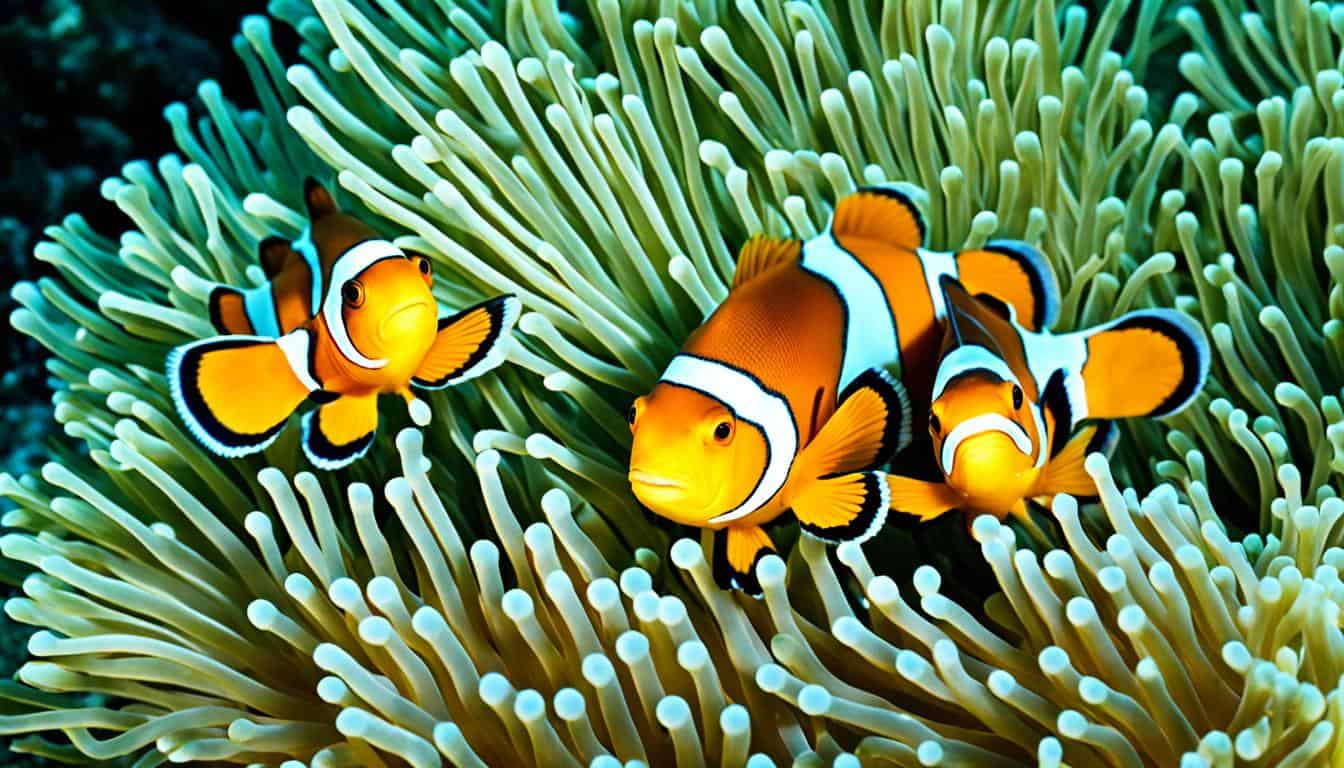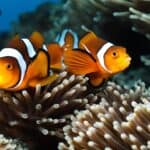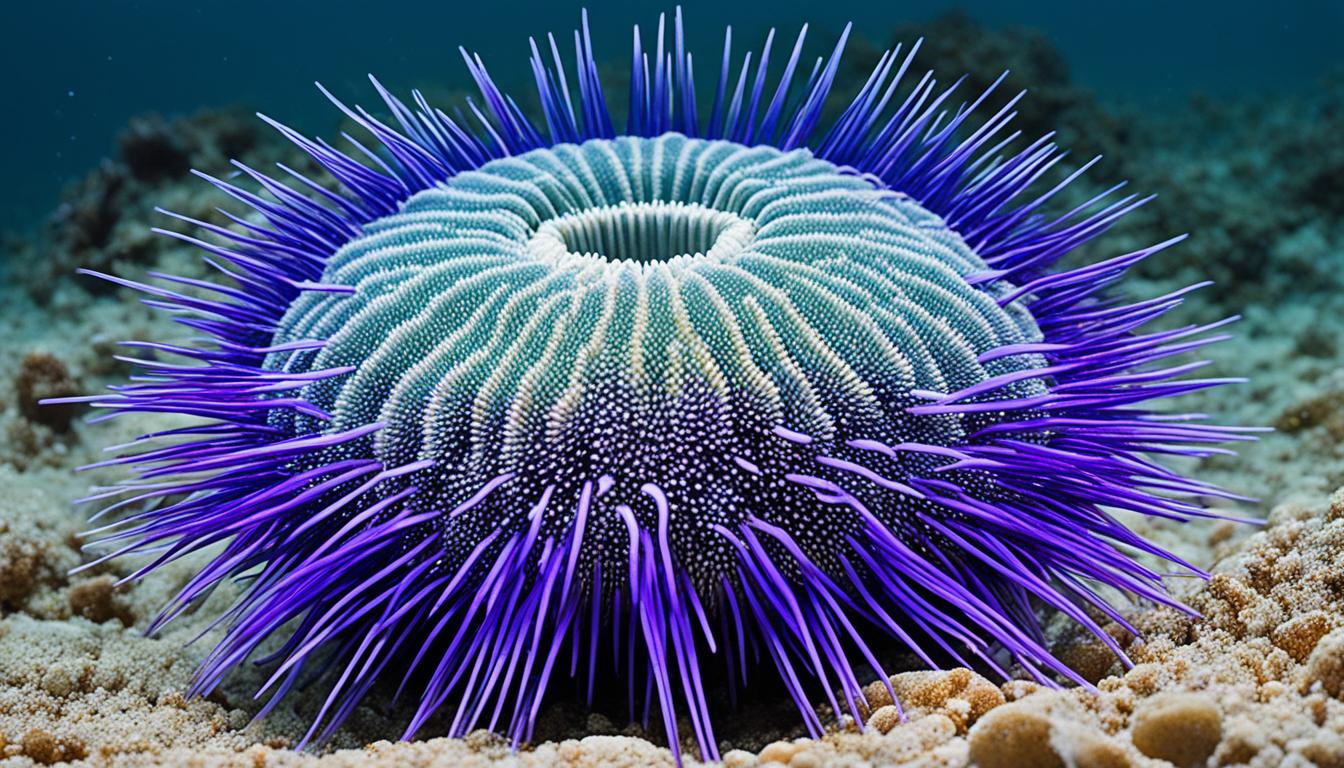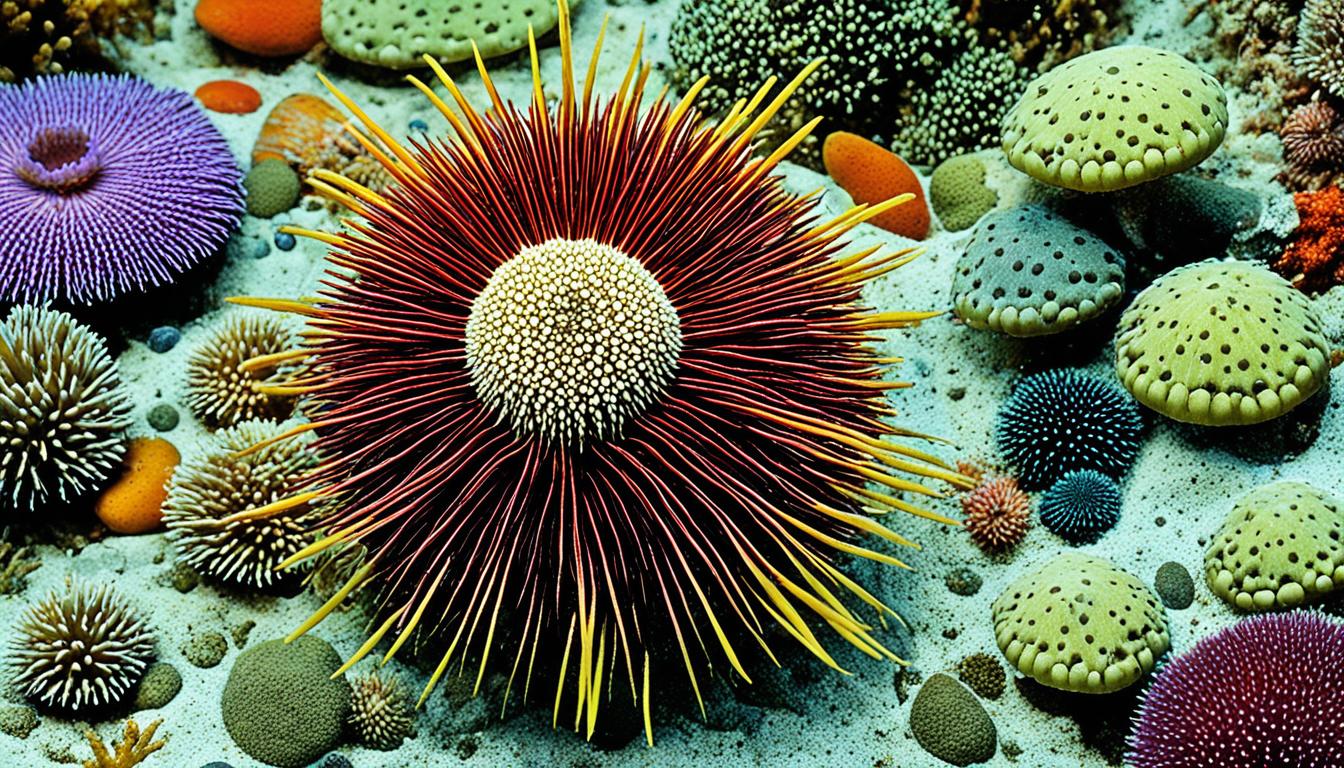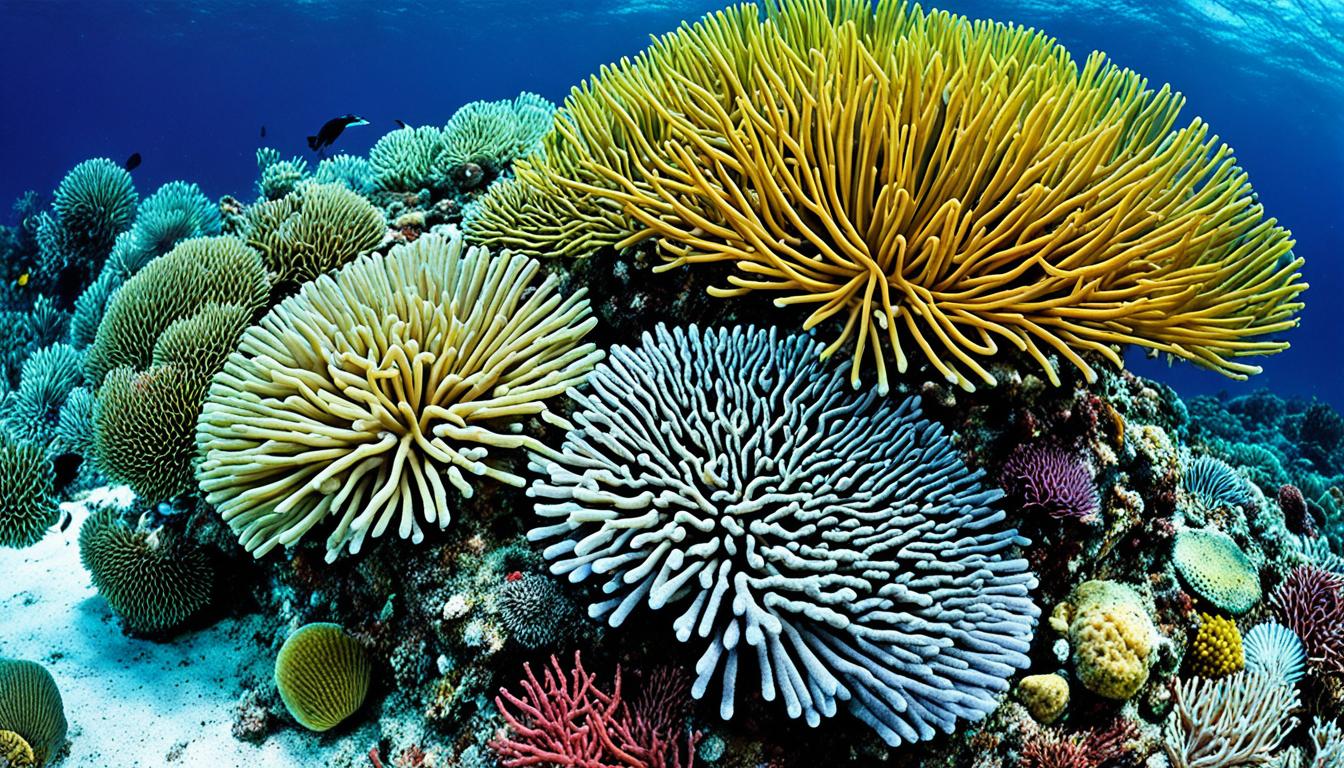Clownfish reproduction is a fascinating process that highlights the complex relationships within this colorful species. These fish are not just eye-catching; they are crucial to marine ecosystems. Let’s dive into their mating habits and life cycle, focusing on their bond with sea anemones. This relationship is key to their survival and helps coral reefs thrive.
Understanding Clownfish Reproduction
Clownfish reproduction is a fascinating process. These marine creatures are known for their vibrant colors and their special relationship with sea anemones. They go through a life cycle that includes external fertilization. A female clownfish can lay between 100 to 1,000 eggs, depending on her health and the environment.
The success of clownfish breeding depends on many factors. These include water quality, the tank environment, and social dynamics. A bonded pair is key for successful breeding. Without this bond, the chances of successful reproduction drop a lot. The presence of potential mates and the right habitat also play big roles in their breeding habits.
| Factor | Influence on Clownfish Reproduction |
|---|---|
| Water Quality | Clean, stable water is vital for health and successful breeding. |
| Tank Environment | A well-structured tank mimicking natural habitats promotes breeding. |
| Social Dynamics | Only bonded pairs will engage in successful mating behaviors. |
| Presence of Mates | Availability of potential mates enhances the likelihood of reproduction. |
Clownfish Mating Behavior
Learning about clownfish mating behavior helps us understand their unique way of reproducing. These colorful fish have a social hierarchy that affects their mating. They don’t have a set gender at birth. Instead, they decide their roles based on their social group.
The biggest clownfish often becomes the female after winning dominance. The second-biggest fish then becomes the male. This setup leads to a special bonding process, vital for their reproduction. The pairs perform elaborate courtship rituals, including mutual cleaning of their nesting sites.
These rituals are key for getting the nest ready for eggs. They make sure the nesting area is safe and clean. Knowing these behaviors is crucial for those trying to mimic their conditions in aquariums.
How do clownfish reproduce?
The amazing process of clownfish reproduction starts with a special bond between the male and female. This bond grows over time, showing through certain behaviors. These behaviors make their relationship stronger.
Bonding Process Between Clownfish
At first, clownfish may fight to figure out who’s in charge. This fighting leads to them acting sweet together, like swimming together and gently touching. As they get closer, the female gets bigger, showing she’s ready to have babies.
Signs of Readiness to Spawn
When clownfish are getting ready to spawn, you’ll see some signs. They start cleaning their home a lot. This means they’re making a safe place for their eggs. Look for these things:
- Frequent visits to the potential nesting area.
- Vigorous cleaning and clearing of the substrate.
- Increased interactions between the pair, such as rubbing against each other.
Seeing these signs means the clownfish are getting ready to breed. It’s exciting to watch and prepare for this big event.
Clownfish Breeding Process
To breed clownfish, you need a great aquarium setup. Getting ready right can really help your fish breed well. Make sure your tank feels like their home, so they can relax and breed easily.
Setting Up a Suitable Aquarium
A saltwater tank is perfect for clownfish. Keep the water clean and stable with good filters and regular care. Add live rocks and anemones for places to breed and hide. Also, make sure the tank is well-lit and the temperature is right, just like their home.
Checking the water quality often is key. Clean water helps with breeding and keeps your fish healthy. Bad water can stress them out and stop them from breeding.
| Aspect | Recommended Level |
|---|---|
| Salinity | 1.020 – 1.025 |
| pH | 8.1 – 8.4 |
| Temperature | 75°F – 82°F |
| Ammmonia/Nitrite | 0 ppm |
| Nitrate |
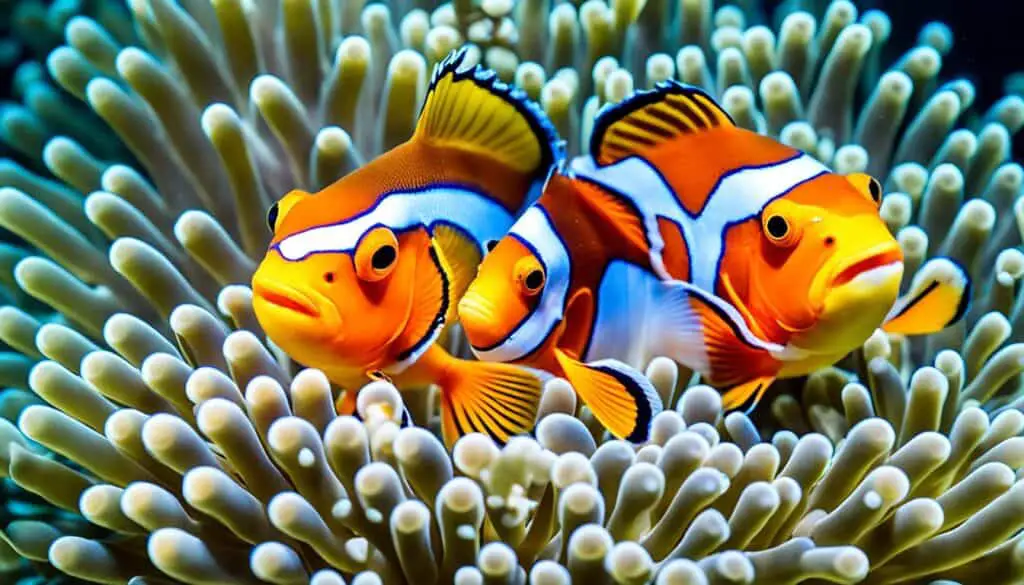
Clownfish Egg Development
After the clownfish fertilization process, the next step is clownfish egg development. The female lays orange eggs that stick to a surface. This starts a 7 to 10-day incubation period.
Both parents play a big role during this time. They keep the eggs safe and make sure they get enough air. This helps the eggs develop healthily.
As the days go by, the eggs start to look different. They turn from bright orange to almost clear, showing the growing babies inside. This shows how good clownfish parents are.
When the incubation ends, the eggs hatch, and clownfish hatchlings appear. These tiny fish start their life in the water, facing new challenges. It’s a big step in their life.
| Stage | Description |
|---|---|
| Egg Laying | Female clownfish lays bright orange eggs attached to a substrate. |
| Incubation | Period lasts 7-10 days; parents guard and aerate the eggs. |
| Embryo Development | Eggs become clearer; embryos can be observed inside. |
| Hatching | Hatchlings emerge as free-swimming larvae, marking a new life stage. |
Clownfish Parental Care
Clownfish show amazing dedication in caring for their young. After the eggs hatch, the male clownfish takes charge. He protects and guides the fry to safe places. This shows how much they care for the next generation.
Clownfish fry need special care, eating live food like rotifers for growth. The parents work hard to help the fry survive. The father keeps a close watch, keeping the fry safe from danger.
This shows how important parental care is for clownfish. They protect the fry from predators and make sure they eat right. This shows that marine parents are just as caring as those on land.
FAQ
How do clownfish reproduce?
Clownfish reproduce through a process called external fertilization. The female lays eggs, and the male fertilizes them. This is key to their life cycle and happens all year under the right conditions.
What is the clownfish breeding process?
Clownfish breeding starts with a pair that goes through courtship rituals. They clean the nest site and lay 100 to 1,000 eggs at a time. These eggs stick to a surface.
How do clownfish exhibit mating behavior?
In clownfish, the biggest fish turns into the female. They show aggression and then affection to form a pair. This is crucial for breeding.
What signs indicate clownfish are ready to spawn?
Look for signs like the nest getting cleaned and the female getting bigger. These mean they might spawn soon.
How should I set up an aquarium for clownfish breeding?
For a breeding aquarium, use clean saltwater, live rocks, and sea anemones. Keep the water clean, lights right, and temperature stable to help them spawn.
What happens to clownfish eggs after they are laid?
Clownfish eggs start developing in 7 to 10 days. Both parents protect and oxygenate them. As they grow, the eggs turn translucent before the fry hatch into swimming fish.
What parental care do clownfish provide for their young?
Clownfish parents are very caring. The male guards the fry and leads them to safe spots. They feed them live food and protect them from danger.

